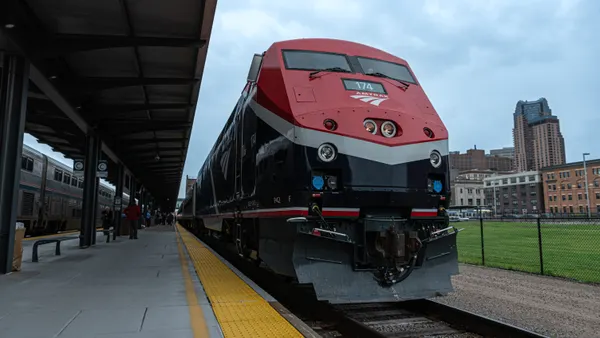UPDATED, March 6, 2019: New York Mayor Bill de Blasio and City Council Speaker Corey Johnson announced upgrades to the city's Fair Fares program, including a plan to expand access, updates on new payment options and a plan to launch a targeted ad campaign.
In a release, the city said it will extend the program to eligible residents under the New York City Housing Authority (NYCHA), students enrolled in the City University of New York (CUNY) system and military veterans below 100% of the poverty line. The expansion will take effect this fall.
In the meantime, the city expects to roll out a pay-per-ride option and a three-month targeted online advertising campaign to raise awareness of the program, both coming in March.
Dive Brief:
- New York City is launching a half-priced transit fare program for low-income residents. Eligible participants are working New Yorkers at or below the federal poverty levels who are receiving benefits from the city. About 30,000 are receiving cash assistance and about 130,000 are receiving food benefits.
- Participants in the Fair Fares NYC MetroCard program will be able to purchase unlimited weekly and monthly transit passes for 50% off the regular price. The cards can be used on any subway or non-express bus line.
- The city is rolling out the program in phases and expects to expand the subsidy program and eventually add in pay-per-ride options.
Dive Insight:
Low-income urban citizens tend to have lower rates of car ownership than high-income residents, and consequently rely heavily on alternative mobility options. The cost of a bus or train ride in New York is $2.75, which can still be cost prohibitive for some low-income residents.
A lack of viable mobility can hinder people's ability to get to work and therefore limits jobs to nearby options. That can further prevent a low-income individual from making more money and finding career success. The new discount program "eliminates an impediment when commuting to work, school or an appointment," said Council Member Ydanis Rodriguez, chair of the city's Committee on Transportation.
Although the program eventually will serve at least 160,000 people when fully implemented with potential future expansion, some say it doesn't go far enough. The New York Times points out that an estimated 800,000 New Yorkers live at or below the federal poverty line of $25,000 for a family of four. Those 800,000 citizens — or a vast majority of them — were expected to be covered under the Fair Fare program, as Curbed New York and other publications reported in June when Mayor Bill de Blasio's administration announced funding for the program.
But the requirements that discounted transit program participants be working and receiving benefits from the state cuts down the number of eligible participants. Some anti-poverty advocates also say the discount would be far more beneficial if it applied to single-ride fares instead of just weekly or monthly, but the city already has said it is working to add that feature to the program.
Although the program will benefit thousands of people, it is off to a rocky start. Besides far fewer people being eligible to participate than first thought, the de Blasio administration took heat for rolling out the program three days late — on Jan. 4 instead of the anticipated date of Jan. 1 — preventing those in need from experiencing the full extent of the benefits. In addition, the whole program was supposed to be rolled out at once, but only one phase has launched, and the larger roll-out is scheduled for April.












